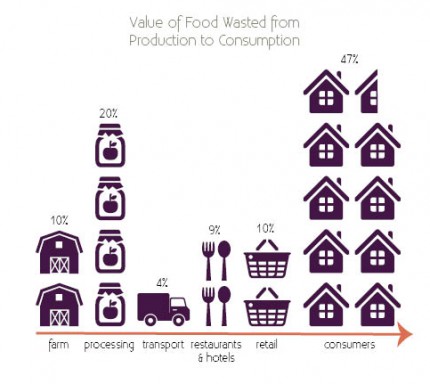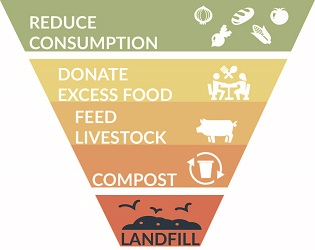Food Waste Series Part 4: The Food Waste Hierarchy
Posted: October 26, 2016
Categories: GoodFoodBites / News from Sustain Ontario
Introduction: Why Food Waste?
Globally, around one third of all food produced is lost or wasted. Canadians currently waste $31 billion worth of food every year, with consumers responsible for almost 47% of the value. Why do we throw away so much food? It turns out that cultural practices, habits and institutionalized social norms play a big part in why we waste food.
The following is part of a five part series about food waste in which we explore how Canadians dealt (and deal) with food in the past, present and future.
The Food Waste Hierarchy
Food waste occurs across the food system, costing Canadians billions of dollars and wasting precious resources and labour. According to VCM International, 10% of the food’s monetary value is wasted at the farm, 20% in processing, 9% in restaurants and hotels, 10% in retail and 47% at the consumer level. This estimate excludes hard to quantify data, which could bring the food waste cost over $100 billion.

Source: VCM International. Design: Sustain Ontario
With rising concern on the subject, municipal and regional programs to educate residents about food waste do’s and don’ts have begun to appear – but there is no federal or provincial Ontario legislation to regulate the issue.
So what does reducing consumer food waste actually look like? Primarily, it means reducing the consumption of excess food. By avoiding the over-purchasing food in the first place we stand to save the largest proportion of consumer food waste. Messaging campaigns, such as the WRAP UK’s Love Food Hate Waste have successfully taken up this challenge, emphasizing the valourization of produce and educating about meal planning and best before dates. The organization estimates that it has avoided the equivalent of 3 million tons of CO2 emissions between 2000 and 2008.

Source: Sustain Ontario
Next, the donation of excess food at the retail level can benefit those who are food insecure. In a province where almost 12% of households face food insecurity, throwing away avoidable food waste is problematic. Although recovering food does not present a final solution to food waste or food insecurity, it is still a stop-gap solution for increasing accessibility to fresh and healthy food. Ontario’s Food Donation Tax Credit, the first of it’s kind in Canada, encourages farmers to donate excess food that does not meet the retail standard. A more controversial bill proposes that food companies receive tax credit for the donation of edible food waste.
Wherever possible, feeding livestock is a time-old solution for processing unwanted food. Although this solution is not available to all (especially city dwellers), the idea of feeding leftover food to pigs has seen some popularity in the UK with The Pig Idea campaign. This type of diversion, where food is consumed by animals or composted, closes the “loop” on food waste, by nourishing animals and creating enriched soil to grow food that circles back into our diets.
Finally, composting excess food avoids the production of the methane gas and leachate that is created when organics decompose in landfills. Local composting in backyards or community sites also reduces the emissions produced by transport trucks when trash or organics bins are picked up and brought to the processing site. Up to half of the residential waste stream can contain organic materials. Although yard waste such as grass clippings and leaves can be bulkier than kitchen waste, the food we throw out is much more costly. Although the diversion of organics is on the rise, this implies that more organics are brought to processing facilities – it does not mean we are producing less food waste.
So how do we reduce our food waste at the regional, provincial or national scale? What does the future of food waste look like? Stay tuned for the next chapter in this food waste blog series: The Future of Food Waste
Missed our previous post on Food Waste from the 1950s to the Present? Check it out here.
Sources:
VCM International – $27 Billion Revisited: The Cost of Canada’s Annual Food Waste
OMAFRA – Food Donation Tax Credit for Farmers
National Zero Waste Council – A tax incentive to prevent food waste in Canada
OpenParliament.ca – Bill C-231 Fight Against Food Waste Act
Statistics Canada – “Is Composting Organic Waste Spreading?”
The Globe and Mail – “Donating ‘edible waste’ to food banks in exchange for tax credit? Now that’s a rubbish idea”
The Pig Idea Campaign
